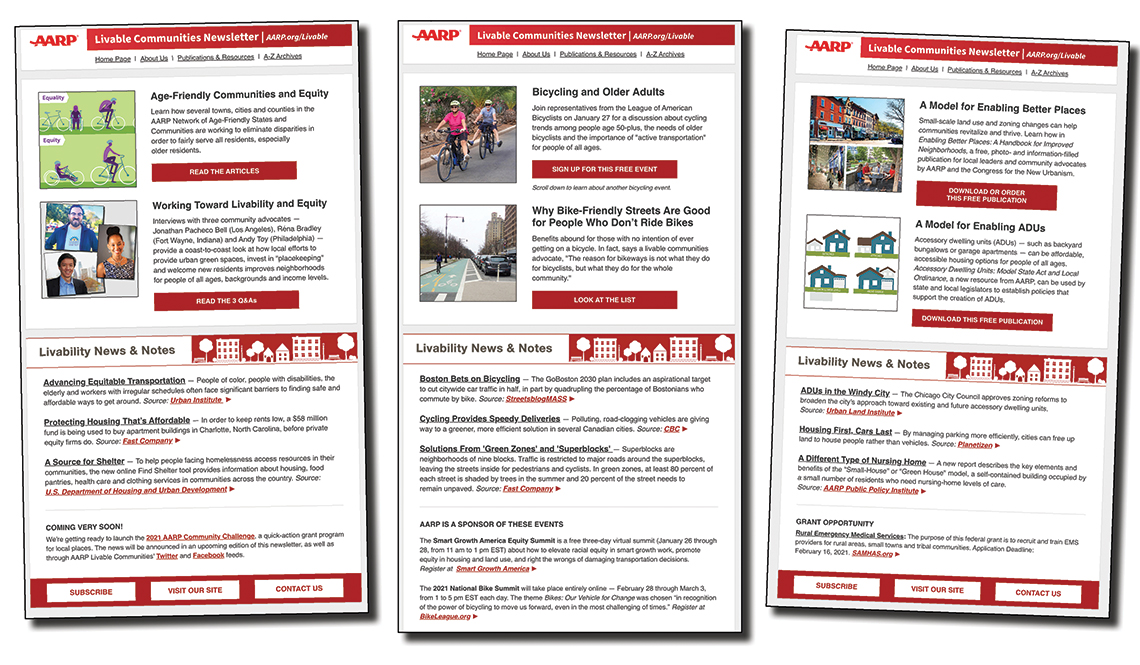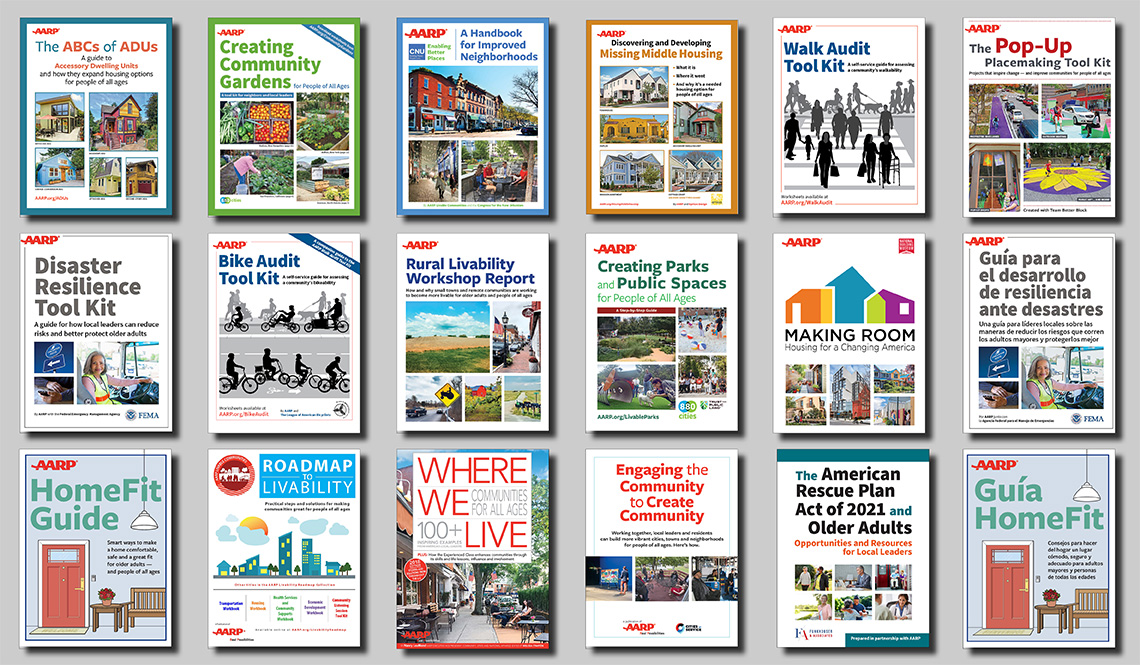2013 Network Conference and Learning Event
October 8 - 9, 2013, AARP Building, Washington, D.C.
The 2013 AARP Network of Age-Friendly Communities Network Conference was an opportunity for community representatives and AARP staff to share valuable experiences, advice and training. Participants presented about both the challenges and successes encountered across all stages of the planning, implementation and evaluation process, and they engaged in an open dialogue about the region-specific and general benefits of the program.
DAY 1
AARP Age-Friendly Community Updates (Part 1)
Suffolk County (Long Island, New York), population 1.4 million, adopted the first countywide Complete Streets policy, an inclusive design mandate on affordable housing, and an incentive ordinance to allow expedited zoning for builders who use inclusive design standards in private dwellings. County officials are supporting transit-oriented development into downtown areas while maintaining the surrounding area’s rural feel. Further age-friendly efforts on Long Island are occurring at both the town (Brookhaven) and village levels (Great Neck Plaza).
Westchester County (New York), population 900,000, has nine regional Livable Community Connection sites throughout the county that are working to promote education and change within the community. When Westchester conducted a Complete Streets week, the work resulted in a countywide Complete Streets ordinance. In the award-winning Caregiver Coaching program, trained volunteers mentor family caregivers, helping them understand their options and make informed decisions about caring for an older or disabled person. There is a significant engagement of volunteers throughout the county for caregiving support villages, which bring together and encourage residents who have common interests to identify community priorities.
Portland (Oregon) was one of the first cities that the World Health Organization reached out to in 2006 upon launching the World Health Organization’s Age-Friendly Cities and Communities Program. Portland was grandfathered into the AARP Network of Age-Friendly Communities when the program debuted in 2012. The Portland State University Institute of Aging conducts focus group research with older adults to get a sense of their priorities and how they experience the city. Portland has recently completed the development of its action plan.
Age-Friendly In Depth at AARP
AARP in the Community: Jeanne Anthony, AARP Education & Outreach project advisor, introduced the AARP Livable Communities initiative and expanded on some of the AARP resources used to promote age-friendly work, including workshops and information focusing on topics of Home Fit, universal design, active living and Complete Streets.
AARP Policy: Rodney Harrell, senior strategic policy advisor for the AARP Public Policy Institute, outlined the principles that support AARP’s Livable Communities work. These principles are designed to improve communities and ensure they work for all people. He also discussed the forthcoming AARP Livability Index, which is being designed as a tool for assessing the livability factors within communities and will support community evaluation and improvement efforts.
Experienced Cities Panel
Deborah Stein, principal planner for the Bureau of Planning and Sustainability in Portland, Oregon, gave a presentation about Portland’s experiences with the AARP Age-Friendly Communities Network. During the planning process, Portland officials attempted to identify what kind of impact the city’s built environment has on its residents’ health. Portland has been fairly successful in achieving a holistic approach that incorporates both the social and physical environment of the city.
Lydia Hernandez-Velez, Philadelphia’s deputy managing director for aging, spoke about age-friendly efforts currently underway in her city. In a February 2013 assessment of Philadelphia, officials identified key areas that need improvement. These include: the access and reliability of transportation; access to affordable housing units and retrofits of row homes; a lack of community engagement with non-English speaking seniors. Hernandez-Velez and other participating officials are working with groups including the Philadelphia Corporation for Aging to foster a more informed discussion with older residents about the programs and services that can support their ability to age in place.
AARP Age Friendly Community Updates (Part 2)
Chemung County (New York), population 88,000, participated in a statewide stakeholder conference about age-friendly living and is in the process of conducting a health assessment to identify gaps in its healthcare spectrum, especially given the rural nature of the county.
Auburn Hills (Michigan), which has a population of 21,000 that swells to 100,000 during the workday, reached out to AARP after Auburn Hills’ planning commission completed a nine-month evaluation in order to identify both the community’s successes and continued improvement needs. In recognition of the community’s efforts to be more age-friendly, in May 2013 Michigan’s Office of Services to the Aging recognized Auburn Hills as a “Community for a Lifetime.”
Austin (Texas) began work to become a more age-friendly community in 2012. Mayor Lee Leffingwell created a Task Force on Aging to combine stakeholders’ efforts to improve infrastructure, create programs and spread awareness. While Austin is often considered a youthful city, its demographic data demonstrates that its population is rapidly growing older. An assessment is underway with assistance from the University of Texas.
Lunch Presentation
Anne Connolly, director of the Aging Well Network Ireland, presented on her country’s Age Friendly Cities & Counties Programme and provided examples of the Aging Well Network Ireland’s key initiatives. Connolly emphasized collaboration with older people’s councils to ensure that the voices of older residents are heard throughout the planning process.
- Aging Well Network: Ireland’s Age Friendly Cities & Counties Programme
- Video: Age-Friendly Kilkenny, Ireland
Focus On Engaging Stakeholders
Kent Sovern, AARP state director for Des Moines, Iowa, spoke about the city’s focus on engaging with stakeholders. The Des Moines plan aims at engaging as many local leaders as possible in the conversation, from all different neighborhoods of the city, to gather feedback to the question, “What affects your ability to live your best life in your community?”
Myrtle Habersham, lead volunteer for Macon Bibb County, Georgia, presented on engaging older residents in the age-friendly initiative. She discussed the importance of providing volunteers with meaningful assignments that are not just busy work, and allowing volunteers to be fully involved in the planning, implementation and evaluation of the city’s plan. In addition, she stressed the importance of valuing volunteer input and providing praise and appreciation for the work the volunteers do.
Focus On: Developing an Action Plan
Part 1: Your Baseline Assessment
Louis Davis Jr., AARP state director, Washington, D.C., discussed his office’s experience conducting a baseline assessment that would engage the widest audience possible in order to account for existing members and networks as well as those currently missing from the conversation.
Sly Majid, chief service officer for the mayor’s office of Austin, Texas, talked about the age-friendly improvements underway in his city and emphasized the responsibility of local leadership in bringing the issue of aging to the attention of the community. Majid discussed the benefits of using demographic and census data to identify trends within the community, community surveys to provide insights on available resources, and asset mapping to observe the distribution of those resources.
Part 2: Developing a Plan Based on the Community Assessment
Will Stoner, associate state director of AARP New York, discussed how the community impact workshop model is frequently used for creating an action plan as it allows stakeholders to participate and outline both the needs and wants of the community.
Focus On Transitioning from Assessment and Planning to Implementation
Anne Connolly, director of the Aging Well Network Ireland, conducted an open session in which she outlined the transition to Implementation and answered questions from participants about:
- Ensuring the development of prioritized projects with clear deliverables, with project owners, multi-disciplinary project teams and associated timelines
- Creating a steering group of stakeholders to hold project owners and agencies accountable
- Focusing on achieving early and highly visible "wins"
- Addressing branding issues and maintaining focus on improving the quality of life for elders while including a multi-generational component
- Developing a communications strategy that includes key messages and key priorities. (Important takeaway: Don’t leave this as an afterthought!)
- Reporting and celebrating successes
- Reporting to elected representatives on an annual basis
DAY 2
Key Takeaways From Day 1
- The work of age-friendly communities can be good for tourism
- There are multiple approaches to conducting surveys and gathering information about different targeted communities, and not all assessments need to be “scientific”
- Communities have different approaches for undertaking their work based on varying priorities and needs
- Age-friendly efforts can and should address the needs of residents of all ages, not just those of the over 65+ population
- Complete Streets is a big component contributing to an age-friendly approach to the built environment in all states/municipalities
- Recognition of the convergence of millenial and boomer generations since the millenials are the second largest cohort next to the boomers
- Addressing the needs of diverse populations is critical. (LGBT is an often-overlooked segment. Also, consider language barriers.)
- Compile and use data to create a compelling story about the change in demographics
AARP Age-Friendly Community Updates (Part 3)
Philadelphia is the first city in the Commonwealth of Pennsylvania to have a Complete Streets policy. City leaders continue to advocate for safer streets and accessible resources for all ages, and recently launched the planning and research agenda Age-Friendly Philadelphia to help older adults remain healthy and engaged with the community.
Washington, D.C., is focusing on ensuring all minority groups are able to voice their concerns and needs and has actively engaged the faith-based community to support the effort. D.C. Mayor Vincent Gray created an age-friendly task force to more effectively cater to the needs of community members.
Des Moines (Iowa), population 500,000, is finishing up its second year as a part of the age-friendly program and is finalizing an assessment report to examine the city’s progress thus far. So far, the biggest challenge has been getting volunteers to do some of the work in the assessment.
Newport (Vermont), population 5,000, is extremely rural, averages 18% below the national poverty line and is rapidly aging. The community is experiencing a significant influx in development, which is contributing to the age-friendly initiative and helping to mobilize residents into an advocacy role.
St. Louis County (Missouri) has 90 separate municipalities, which presents difficulty in working toward unified goals. Preparing for an older population is a major component of St. Louis’s 2013 Strategic Plan Update, which is mostly data-driven. The city has done some GIS mapping and analysis and plans to conduct research into homes in the community with features of universal design.
Macon-Bibb County (Georgia) is almost finished with its second year of the program and is moving from the planning stage to the implementation stage. One major plan in the works is to transform Second Street, a main road in the downtown area, to accommodate the needs and lifestyles of all community members. The city/county government is in a state of transition, which introduces some roadblocks in moving forward with any major policy changes.
Wichita (Kansas) is still in the early stages of the planning process. Community leaders worked out a five-year strategic plan after completing a workshop with Dan Burden. Wichita is in the process of electing a new mayor, so the community assessment will have to account for that change in leadership by incorporating more community buy-in. As the city is politically conservative it will be important for Wichita’s leaders in the cause to show some action before additional planning can be completed.
Maintaining Momentum Through Changing Political Leadership
Karen Cooper, AARP Georgia associate state director for community outreach, offered insight into the unique situation of Macon Bibb County, Georgia, which is undergoing a merging of the Macon and Bibb county governments. Cooper spoke about how AARP Georgia is working to maintain momentum on the age-friendly initiatives in Macon Bibb County through the shifting political leadership that is occurring.
Kelly Stoddard Poor, AARP Vermont associate state director, also presented on maintaining momentum through changing political leadership. She said it is important to focus on long-term goals, while also being mindful of short-term campaign goals that depend on which leaders are in office at the time. She offered advice about effectively using grassroots advocacy and the media to raise awareness of the age-friendly initiative.
Stay Informed — For Free!
AARP.org/Livable
Enter a topic, name, place, etc.



